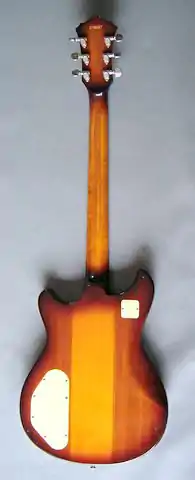

Neck-through-body (commonly neck-thru or neck-through) is a method of electric guitar construction that combines the instrument's neck and core of its body into a single unit. This may be made of a solid piece of wood, or two or more laminated together. The strings, nut, fretboard, pickups and bridge are all mounted on it, with additional body side components (if any) filling out its full shape glued or mechanically attached are referred to as "wings". The technique is also used on electric bass guitars.
Neck-through-body construction is considerably more expensive than the traditional glued set-in neck and bolt-on neck style construction methods. However, it's less costly than the very rare and difficult "one-piece" fabrication out of an entire instrument fabricated out of a single piece of material.
History
The first electric bass guitar, the solid-body "Audiovox 736" created by Paul Tutmarc circa 1937, had a neck-through construction.
"The Log", a prototype solid-body guitar built by Les Paul in 1941, can be considered as a forerunner of neck-through designed instrument. Les Paul built the model using a recycled 4x4 fence post as the neck and body core, and mounted the disassembled parts of an Epiphone and Gibson archtop guitar onto it.

The 1952-57 Harmony H44 had this construction feature.
In 1956 Rickenbacker was one of the first guitar manufacturers to use the modern variant of this technique, although this was originally restricted exclusively to semi-hollowbody guitars.[1]
Pros and cons
Neck-through construction is significantly harder to mass-produce than bolt-on or set-in neck constructions and is primarily found on high-end guitars. It is somewhat more common in basses than in guitars.
The most important benefit for the player of a neck-thru guitar is the reduction in heel mass which is an obstacle when attempting to reach the higher registers of the fretboard. Neck-through construction allows easier access to higher frets because there is no need for a bulky heel — the thickened area of the neck where it attached to the body. When constructing a neck-through guitar the luthier can chamfer the heel to a minimum, sometimes almost relieving the heel entirely, allowing unhindered access to the upper registers.
On top of easier high fret access, many musicians assert that neck-through construction provides greater sustain, richer overtones and allows the instrument to stay in tune longer due to the increased stability inherent in the design. Essentially, both ends of the string are tied down to the same piece of wood that runs the length of the instrument, so all the strings energy's running across the entire instrument, with no join to limit or filter the string's harmonic production.
Repairs to the neck are usually expensive and tedious. In many cases, it is usually easier to remove the old neck completely, either by taking the wings off and putting an entirely new core in, or by converting the guitar to a bolt-on or set-neck by creating a heel and affixing the new neck to the core already in place, rather than to try to repair the neck itself. However, thanks to excellent stability and reaction to string tension and pressure, neck-through guitars tend to be more sturdy.
Use
This structure is used by many companies, including Parker Guitars, BC Rich, Yamaha, Cort Guitars, Ibanez (primarily on basses), Jackson, Alembic, Schecter, Carvin, ESP Guitars, and Rickenbacker.
Many configurations of the Gibson Firebird and Thunderbird are also built neck-through.
The construction method is also popular with independent guitar builders, who can typically devote more time to such a labor-intensive neck joint than a mass-producing company could.
References
- ↑ Rickenbacker International Corporation: The Modern Era of the Electric Guitar, retrieved 14 June 2012